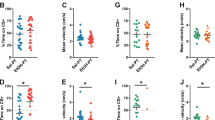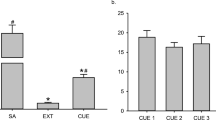Abstract
Rationale: GABAA receptor antagonists have been shown to reduce ethanol self-administration and ethanol-induced conditioned taste aversion (CTA) in rats, suggesting a role for the GABAA receptor in modulating ethanol’s motivational effects. Objectives: The present experiments examined the effects of the GABAA receptor antagonists, bicuculline and picrotoxin, on the acquisition of ethanol-induced conditioned place preference (CPP) and CTA in male DBA/2J mice. Methods: Mice in the CPP experiments received four pairings of ethanol (2 g/kg) with a distinctive floor stimulus for a 5-min conditioning session (CS+ sessions). During CS+ sessions, mice also received bicuculline (0, 1.0, 3.0, or 5.0 mg/kg) or picrotoxin (2.0 mg/kg) before an injection of ethanol. On intervening days (CS– sessions), the pretreatment injection was always vehicle followed by saline injections that were paired with a different floor type. For the preference test, all mice received saline injections and were placed on a half grid and half hole floor for a 60-min session. For the CTA experiments, mice were adapted to a 2-h per day water restriction regimen followed by five conditioning trials every 48 h. During conditioning trials, subjects received an injection of vehicle, bicuculline (0.5 and 2.0 mg/kg), or picrotoxin (0.75 and 2.5 mg/kg) before injection of 2 g/kg ethanol or saline following 1-h access to a saccharin solution. Results: Both picrotoxin and the lowest dose of bicuculline (1.0 mg/kg) significantly increased the magnitude of CPP relative to vehicle-treated controls. Picrotoxin alone did not produce place conditioning. Ethanol-stimulated locomotor activity was significantly reduced during conditioning trials with picrotoxin and the higher doses of bicuculline (3.0 and 5.0 mg/kg). Bicuculline did not alter ethanol-induced CTA; however, picrotoxin dose-dependently increased the magnitude of ethanol-induced CTA. Bicuculline and picrotoxin did not produce CTA when administered alone. Conclusions: Overall, these results suggest that blockade of GABAA receptors with bicuculline and picrotoxin enhances ethanol’s motivational effects in the CPP paradigm; however, only picrotoxin enhances ethanol’s motivational effects in the CTA paradigm.
Similar content being viewed by others
Author information
Authors and Affiliations
Additional information
Received: 12 September 1998 / Final version: 21 December 1998
Rights and permissions
About this article
Cite this article
Chester, J., Cunningham, C. GABAA receptors modulate ethanol-induced conditioned place preference and taste aversion in mice. Psychopharmacology 144, 363–372 (1999). https://doi.org/10.1007/s002130051019
Issue Date:
DOI: https://doi.org/10.1007/s002130051019




